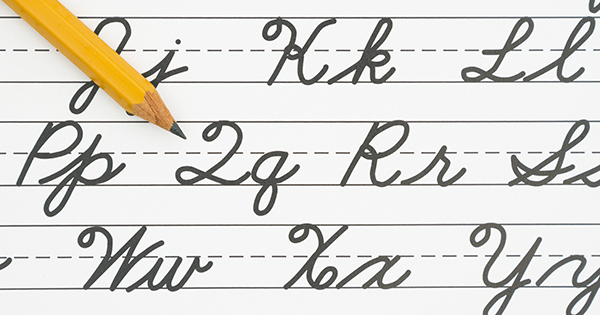Is Cursive a Dead Language?
December 12, 2018
Many students who still loop their letters together are often met with girls’ shrieks of “Your handwriting’s so pretty!” or teachers’ affirmative remarks of “What excellent penmanship.” While a majority of students and even adults shun the effort that writing in cursive requires, a select few still preserve the lost art–granted, to different levels of success. What is it about cursive and the teaching of cursive that has turned its presence into a rare occurrence that earns a mention?
Common Core standards do not require cursive to be taught in schools anymore, often in exchange for a course in keyboard proficiency, something deemed more “useful”. But, does that mean we should simply await its extinction through ignorance? A shocking proportion of high school students and even adults are unable to simply read cursive, even though Kate Gladstone, a handwriting expert, though not a fervent supporter of the preservation of cursive, admits in her article to the New York Times, “Reading cursive can be taught in just 30 to 60 minutes — even to five- or six-year-olds, once they read ordinary print.” Printing has been shown to be a wiser choice for younger children still becoming acquainted with individual letters and sounds. However, once this has been overcome, cursive is no difficult task for even five-and six-year-olds to take on, even in a short amount of time. Clearly, translating the curved letters is no difficult feat, and every high school student or especially adult should be more than capable of decoding the words, including the documents of history penned with most graceful, flowing, dramatic script.
Reading cursive is one thing. But how much of a motivation still remains for us to be perpetuating the passing down of the classic Zaner-Bloser alphabet? Even the adult world is divided on the supposed benefits of cursive. Jimmy Bryant, a contributor to the New York Times, sees value in cursive to preserve the cherished documents of history for all generations, often constructed with care, but bold, cursive. While this is a valid point, many see cursive as an old-fashioned tradition that has become obsolete and archaic. Morgan Polikoff, an assistant professor at the University of Southern California, looks toward the digitized future. He believes that the increased reliance on information being stored online negates the need for cursive. He asserts his extreme opinion in his article, aggressively titled, “Let Cursive Handwriting Die,” where he posits, “Teachers would be better off focusing on the skills and knowledge that will impact student success in the future. These include printing and typing, but not cursive.”
While many individuals in society clearly has their own passionate opinions on the subject, concrete studies suggest some benefits. Those in favor of cursive are in good company – the College Board reports that in the high stakes of the SATs, students who write in cursive on the essay portion boast higher scores. And this correlation might just be plausible – it has long been suggested that writing in cursive is faster and more efficient than printing. This allows students to focus on the content of what they write once they tackle the mechanics. Also, in the stressful atmosphere of a timed essay, those who can get more information down on paper may have a greater opportunity to get all of their ideas across. In children, writing in cursive stimulates brain activity and develops fine motor skills that are capable of setting them apart for the rest of their lives.
So, when it comes down to it, should we teach cursive in schools in an effort to preserve it or not? An interest and more specifically a passion, for handwriting has become increasingly rare and is simply not as useful as it has been in the past. Today ushers in the digital age, which will only gain momentum as time progresses. Is there room for cursive in this future? Proponents argue yes, but their zealous opposition refutes that claim. The only reasonable conclusion to draw among all this controversy is that we must decide. To appease the largest amount of people, students should be introduced to cursive in school. However, once they have achieved proficiency, it is not necessary to enforce it. And what about those historical documents? Well, we must trust in those students who will take what will be seen as an unconventional interest in handwriting to continue on that road, and adults around them should encourage it in order to create the historians and old souls that will carry the past on their shoulders into tomorrow.









